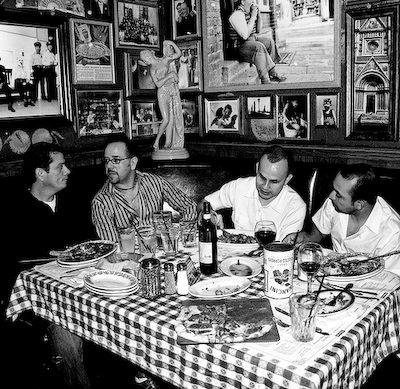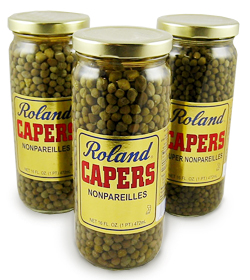| Media Contact: | Skip Lombardi |
| 941.539.9727 | |
| E-Mail: info@almostitalian.com | |
| Almost Italian Web Site |

Italian Restaurant Scene
In 2004, Skip Lombardi's cookbook, Almost Italian, captured the hearts of Italian-Americans with kitchen anecdotes and recipes gathered from scores of Little Italy communities. Currently unfolding on the World Wide Web, his greatly expanded and illustrated second edition of Almost Italian is making readers hungrier than ever as they wait for the next installment.
Now anyone can read Almost Italian (2nd Edition) on-line. The postings began September 19, 2007 and will continue until the entire book has been offered to readers. Reader access to the on-line edition is free of charge.
Mr. Lombardi celebrates the spirit of Italians who arrived in America during the huge waves of European immigration in the late 19th and early 20th centuries. Rich culinary traditions accompanied even the poorest Italian immigrants who settled here and found a gastronomic landscape of both limitation and opportunity.
Initially, some of the ingredients essential to their cooking—olive oil, sheep's milk cheeses, and even pasta—were unavailable. But at the same time, the new immigrants were amazed to discover they could afford other ingredients that, in the old country, had been out of their financial reach—most notably, larger quantities of meat and chicken. Both lack—and abundance—inspired an entirely new cuisine, what we have come to know as Italian-American.
The 2004 edition was a collection of 87 recipes. Though indisputably Italian-American, most of the dishes were virtually unknown in Italy. But times—and food—have changed. Some dishes of American invention have begun appearing on trattoria menus in Italy. American-Italian cuisine itself is constantly evolving as more of us travel to Italy and come back with our own notions of what's Italian. Once-exotic imports sold only by specialty grocers in urban Little Italys are now supermarket staples in towns across America. And thanks to advances in Internet technology, those who produce, sell, cook, or simply enjoy Italian ingredients can converse and interact as never before. The network for food research—and sharing the pleasures of the table—has grown exponentially.
"More than ever, the medium is the message," declares Mr. Lombardi, "so my editor and I thought: why not serialize the second edition of Almost Italian as an on-line blog?" He goes on to explain...
"In September, I began posting what will eventually be the entire second edition of the book, beginning with a revised introduction. As my editor and I work through my material (much of it new to this edition), I'm planning to publish two or three recipes each week on the Almost Italian blog.
The recipes will range from antipasti to dolci. For me, the stories behind many old favorites—dishes like Caesar Salad, Clams Casino, Cioppino, Lobster Fra Diavolo, Stromboli, and Veal Parmesan are as delicious as the preparations themselves, and I can't wait to share them. So, I encourage readers to bookmark the blog and check in often to enjoy each update as soon as it is posted.
As I move along with the project, I'll be soliciting my readers' participation. I want them to realize that the culinary history of Italians in America belongs to all of us. I'll be asking them to e-mail me stories, old photos, recipes, menus—anything they want to share. For any material I choose to post on the blog, I'll be delighted to include a credit and a link back to the contributor. The second edition of Almost Italian will reflect the fact that the Internet makes it easier than ever to be part of a community."
Skip Lombardi, a professional musician, food writer and chef, grew up in an extended Sicilian-American family in which his maternal grandparents carried on the food traditions of Sicily—baking bread, curing olives, and tending their backyard grape arbor. But his real exploration of food began when he had yet another career, as a software designer, and moved to what he calls "Boston's Red Sauce District," the city's historic, Italian North End.
Mr. Lombardi says...
Though I miss the North End, I think of the Web as the perfect kitchen in which to combine my experiences in programming with my affinities for prosciutto, pasta, and pecorino Romano.
I know this second edition of Almost Italian will be a different and far more engaging book than the one published just three years ago. My fundamental belief—that there is no situation that can't be improved by a plate of pasta with a little of my Nonna's marinara sauce—remains unshaken.
I look forward to sharing my passion for food with a new audience, and with everyone who enjoyed the first edition of Almost Italian.
Here's a sneak preview: just the type of recipe you can look forward to in the weeks ahead.
Chicken Piccata
Chicken with Lemon, White Wine, and Capers

Salt-cured Capers
Ingredients:
4 Chicken breasts, skinless and boneless
3/4 Cup all-purpose flour
2 Tbs. Olive oil
2 Tbs.Unsalted butter
1/2 Cup white wine
Juice of 1 Lemon
2 Tbs. Capers, rinsed and drained
Salt and freshly ground black pepper
Additional 2 Tbs. Unsalted butter (optional)
4 Tbs. Flat-leaf Italian parsley, finely chopped
Preparation:
Place the chicken breasts between two sheets of plastic wrap and pound them with a meat mallet or a rolling pin until they've reached a uniform thickness of approximately 3/8 in. Season the breasts on both sides with salt and pepper and set them aside.
Pour the flour into a shallow-sided dish and season with salt and pepper. Dredge each chicken breast in the flour and reserve them on a plate.
Heat a sauté pan over medium-high heat, then add the butter and the olive oil. When the butter has foamed and the bubbles have begun to subside, sauté the chicken breasts for about 2 minutes per side, or until they begin to turn white around the edges.
Raise the heat to high, add the wine, lemon juice, and capers, and stir with a wooden spoon to loosen any caramelized bits of chicken that may have stuck to the bottom of the pan. Boil for 1 — 2 minutes to evaporate the alcohol, and to reduce the sauce. If using the optional butter, add it now. With the pan more off the heat than on, stir the melting butter to incorporate it with the sauce.
Taste for seasoning, and add salt and pepper as necessary. Remove from the heat.
To Serve:
Serve one chicken breast on each of four dinner plates, garnished with additional parsley. Broccoli or asparagus, and garlic mashed potatoes make great accompaniments.
Serves four
###